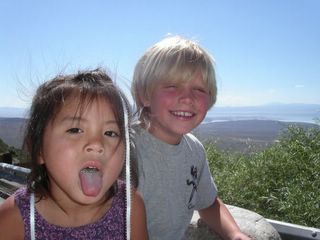Señor de Los Tremblores


It is our good fortune to be visiting Peru during Easter Week. Most cities in Peru, and throughout Latin America, have a number of parades and processions during Semana Santa, the week preceding Easter and Cusco is no exception. Indeed, almost every Sunday the morning, the streets around the main plaza are blocked off, a tent is set up in front of the cathedral for local dignitaries, and various groups, including the military, parade around the plaza. Almost any event will do for a parade. One week it was the anniversary of a local girls´ school, another week it was the beginning of lent. On Tuesday, the merchants at the Molino Central Commercial Market participated in a parade celebrating the anniversary of the market. The market consists of a huge collection of small stallholders who sell everything from coca leaves to light bulbs. Given the presumably meager sales of each of the individual stallholders, I was very impressed with extravagant costumes.
While Easter is the reason for the season, the big event in Cusco occurs on the Monday before Easter for the procession of Señor de Los Tremblores. This has been going on since the great earthquake of 1650 when many of the Spanish Colonial structures collapsed. Attributing the disruption to Divine intervention, the locals paraded a large 10’ crucifix throughout the city and, miraculously, the earthquake stopped (but don’t they all eventually?) I wonder if someone wasn’t wearing a T-shirt emblazoned with the words, “Stop Plate Tectonics!” Anyway, since 1650, the Señor de Los Tremblores is trotted out for a little fresh air and a jaunt around town on the Monday before Easter. You can see the picture below. They take their fiestas seriously in Cusco and this is a big affair. The event is televised live and it’s not just the cable public access crowd tuning in; of all of the televisions I saw that afternoon, both of them were tuned into live coverage of the procession of the Señor. By that evening, when Señor de Los Tremblores was marched back through the main square before being put back in his gilded cage for another year, the plaza was jam packed with people. I’m not too good at estimating the size of crowds but no portion of any sidewalk, street, or walkway was visible through the throng; there must have been several thousand people. While we may have missed some of the excitement of being packed in like sardines with complete strangers on a cold evening in favor of viewind the event with some pisco sours next to a roaring fire in a nice restaurant (Kusikuy) nearby, we have really been enjoying all of the processions and parades in Cusco.
Luckily, the Easter Bunny did indeed find us down here in Cusco, thanks to some planning by Mary. It was, of course, very difficult to sleep in with candy hidden about the house so, after an early morning repast by M&M Mars, we headed into town for Easter service at the cathedral. In an effort to stamp out Incan pagan worship and convert the natives to Christianity, the Spanish often built churches on top of Incan holy places and the cathedral of Cusco is no exception; it was built on top of an Incan palace with stones pilfered from the nearby Incan ruin of Sacsaywaman. Construction on the cathedral began in 1550 and went on for almost 100 years. It was no surprise to see the cathedral full on Easter morning, there were even a couple of dogs resting peacefully near the confessional booth, but we were able to find a good place to stand near one of the side altars. After the service, we wandered about the church with others who were praying to particular side altars. We stopped to admire the Señor de Los Tremblores who was back in his usual altar on the right side. The Señor, like many figures in various churches was attired in a beautifully embroidered piece of clothing. This particular garment consisted of a bright blue wrap around his waist with brilliant silver and gold accents. I looked at the crucifix for some minutes, praying, before I noted the words canal (channel) 41 in gold embroidery on the vestment. Once I picked that out, I saw that the silver web embroidered in the lower right corner was actually a satellite dish with the letters M, T, and V in gold bouncing off of the dish (see below). One of the things I really like about Cusco is the lack of corporate commercialization. There are no McDonalds or other fast-food restaurants and the big box retailers have not yet come to town. And, while I do think that the commodification and commercialization of virtually all aspects of contemporary society is a far more dangerous corruption than sex or violence, I had to admire the pluck of this particular sponsorship opportunity; perhaps this is something Mary´s hospital is going to want to get onto quickly.


0 Comments:
Post a Comment
<< Home